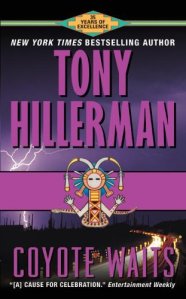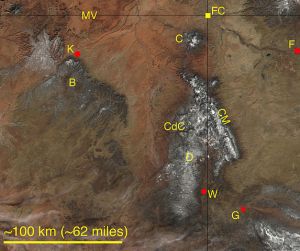In Navajo mythology the Milky Way was created by the trickster god, Coyote. Coyote also created the world and the Holy People. The Holy People were assigned the task of helping populate the universe with stars. The Holy People were too slow for Coyote's liking and he took their bag of stars and threw them into space, creating our nighttime sky.
Coyote is a trickster god. He would often masquerade as a well-known man after having transmuted the man into a coyote. Coyote would use the man's reputation to his advantage, often trying to sleep with the man's wife. Coyote would also use deception, lies, and trickery to obtain objects of his desire, for despite his supernatural existence, he enjoys the carnal and superficial pleasures of humans. Sometimes, Coyote is benevolent. In "Coyote Kills A Giant," the god finds a way to kill a giant and save his people from death.
 |
| "Coyote Waits," by Tony Hillerman |
The death of the officer elevates the crime beyond Officer Chee and his supervisor, Lieutenant Joe Leaphorn, and into the hands of the FBI. Neither Chee nor Leaphorn are comfortable with Federal law enforcement acting on tribal lands and both initiate their own investigations.
The nuance of the faith healer's involvement bothers both Navajo officers. The officers aren't too fond of the FBI immediate guilt placed on Pinto. Ashie Pinto was not currently known to be a drunk. The crime scene was also hundreds of miles away from Pinto's home, and Ashie doesn't drive. So, what was a medicine man doing hundreds of miles away from home, drunk, with the murder weapon?
Chee's and Leaphorn's investigations lead them along intersecting paths through Navajo culture and lands. Chee is a traditionalist, himself practicing to be a healer, a Navajo medicine man. Leaphorn, while older, is less attuned to his Navajo heritage, familiar with but distant from the spiritual beliefs, family lineage and tribal membership characteristics of his fellow Navajos.
The dichotomy between Chee and Leaphorn provides wonderful insight into Navajo culture and spiritualism. Chee's interest in Ashie Pinto's jish, a small bag containing a shaman medicinal items, provides insight into the importance of traditional medicine and spiritualism within Navajo culture. Chee's developing friendship with Assistant District Attorney Janet Pete illustrates the complex relationships between Navajo tribal society and the non-Navajo society. In Navajo tribal culture knowing a person's tribal affiliation, such as the Bitter Way tribe or the Slow Talking Dinee can determine who a person can marry and whom a person can't.
 The
search for evidence leads Chee and Leaphorn across the landscapes of
Arizona and New Mexico. From the University of Northern Arizona, the
Chuskas Mountains, to the Four Corners, the officers cover the geography
of northeast Arizona and northwest New Mexico.
The
search for evidence leads Chee and Leaphorn across the landscapes of
Arizona and New Mexico. From the University of Northern Arizona, the
Chuskas Mountains, to the Four Corners, the officers cover the geography
of northeast Arizona and northwest New Mexico.Through Chee and Leaphorn we learn about studies of Navajo history and language at UNA and programs to preserve Navajo language and stories at the University of New Mexico. Chee and Leaphorn both run across a Vietnamese immigrant, a school teacher, whose presence illuminates a diversity in culture beyond Navajo and White, illustrating again the dynamics of today's society.
Chee and Leaphorn also discover the lengths people will design in order to track down the ellusive tales associated with notorious American train robber, Butch Cassidy.
Hillerman's stories are immediately engaging and likeable. Chee and Leaphorn provide an interesting contrast in characters. The younger Chee is more traditional and schooled in Navajo culture. The older Leaphorn, well-respected among folks of all backgrounds, is pragmatic and less bound in Navajo tradition despite being Navajo. Hillerman blends Navajo tradition, Navajo culture and history, Navajo language, and academic efforts into an enjoyable tale of how the Coyote Waits patiently in order to gain his prize.